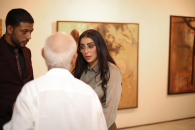Artistic events since 1972 |
Group exhibition titled "Convergences"at BCK Art Gallery. Marrakech, 2022 |
|
     |
Convergences: three palettes and a sculptor |
In their new exhibition placed under the theme (Convergences), the four visual artists (Abdelkarim el Azhar, Mahi Chafik-Idrissi, Mohamed Najahi and Mostaha Daif) chose to be presented to the large public of Marrakech through four different plastic experiences, which vary between a strong formal abstraction at (Abdelkarim el Azhar), a pure abstraction dominated by the color, the sign and symbol, sometimes relying on the letter of Arabic calligraphy, as a tool to anchor the meaning of the work at (Mahi Chafik idrissi)
Mahi Chafik-Idrissi opts for the expressive force of symbol and color, especially when the latter becomes, in itself, style and technique, fields and means of aesthetic amazement, so that the painter, by poetizing his painting, aims to embellish and deepen the meaning of many elements on his canvas. With the aim that the meaning itself, is no longer the issue of contemporary art (especially in its abstract phases): these poetized and singing canvases of Mahi Chafik6Idrissi lead the color to its most energetic meanings. From there, the color, remains an emblem, an expression or a dominant element and becomes, at the same time: signifier and signified in this plastic experience. What allows the painter to be also a colorist par excellence. |
|
|
Boujema El Aoufi
Poet and art critic
|
|
Eulogy of coincidence |
|
« […]this staging of Memory insists on the fact that the Future is assumed in the content of a Memory ».
Georges Garrouste (1984) |
One often wonders what is authentic about this exhibition. First of all its diversity puts in scene a state of mind which, by its questioning, shakes the emotion of a contemplator and moves him beyond the limits. It follows the logic of rigor as far as possible with the spiritual and expressive gesture of Mahi Chafik-Idrissi, questions the immemorial and patrimonial traces of the past at Najahi, diverts the gaze towards a fragmented and constrained body in El Azhar and finally challenges the perceptive visualization through a sculpted representation in Mostafa Daif. It seems that this exhibition has granted the artistic state the alibi of its own propulsion but also of its tensions at the confluence of the subjective and the objective. That there is an outcropping in the consciousness of each artist among them of archetypes, knowledge or buried events. Here, everything is intertwined. Thanks to the matter, coloring or component, the work of each one is presented like a bed on which rests fragments with their symbolic value: El Azhar furrows with his reconfigured faces the narratives of the everyday life by instilling sometimes a dreamlike vision to the real. He proceeds by formal massification in order to individuate the fragmented body according to an immobile movement. His technique as well as his conception marry the cadence of time, the erosion of the invisible with all its emanations and let themselves be guided by the intimate conviction of a typical plastic and graphic adventure. It is this adventure that makes the already there happen in Najahi, a surveyor of the traces buried in the memory of the walls of the city of Marrakech. Borrowing the material of the land, he sublimates the scratches of the wall surfaces and reinvents the ontological path of a city and a man according to the polyphonic and tinted sedimentation of existence. His archeological approach refers to a whole heritage problematic with the metonymic meaning of the undertones. It is almost similar, with Mahi Chafik-Idrissi who uses the trace/sign to give more thickness and values to the rigor of his painting. One could say that there is here the brilliant synthesis between spirituality, the expressiveness of the hazardous gesture and the latent tension between states of mind. It is also the projection of a rhetoric of the sign relayed by a more ample and articulated analytical vision of his painting. On the surface, the sign with him imposes its controlled soft violence; the whole constitutes a semantic of features with diluted magic effects.
Other is the magic of Mostafa Daif who gives form in relief to bodies shifted and almost "defunctionalized". Endowed with power, this technique models the support/wood on which the sculptural activity is exercised and supports the idea of a path that passes through the masses sinking into the depth of vision. It is also a formal intention that sets landmarks and enchants the body by transposing it into organic codes.
From there, four types of representation in the heart of the story, that of the man and the inhabited or projected space. Four perceptions which cannot be objective, because they are read like an identity reconstitution of the being there. The continuum of his exhibited works is then carried out according to our experience, our memories, our affectivity, our imagination or simply our activities. That we consider the step and the thought of these artists, their work implies henceforth the same mode of conception, their borders blur to be integrated within the same spectacle, that of the life and its corollaries. Their work leads us towards an absence pushed to its exasperation; it is the will-to-be of the man who is represented. Its vital force with its unconscious reactions which are tested in the artistic composition. Each artist has his own style, and each style is an expression of thought. But the visual space that creates their work is supposed to continue outside, which is only a fragment of reality, a dialectical agreement of the spiritual and the material. |
|
|
Hassan Laghdach
Art critic |
| |
|